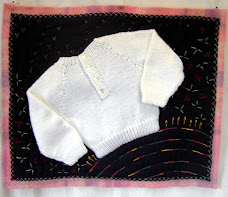Evelyn of North Bundaburg wrote to tell us about the "wagga principle" extended to covering walls with opened out hessian sacks. She also remembered making head coverings from sacks.
Eric Crowley, was born and grew up in Barraba, Northern NSW, far away from the Murrumbidgee wheat area. He remembers going into the shearing shed to get a wool bale to make a wagga. He would fill the bale with hay, and then depending on the weather he would sleep on top of it or use it as a cover, sometimes even getting inside the bale with the hay. Because of the size of the bale there was no need to join them or even open them up.
Val's husband grew up in Western Australia, to him a wagga is a sugar bag. If two need to be joined 3 nails were used – one in the middle and one at each end.
Mirium remembers using a brick as a template to cut out the wool fabric to make a domestic wagga.
Neville of Cowra showed us how to use a wheat bag as a head covering to protect him when carrying bags of wheat.
Pete's story: remembers his father stitching potato sacks together in the shed to make blankets for the itinerant workers
Another aquaintance, Judy, told us how she use to help her mother make a wagga for her father to take on his droving trips. They were so full of dust on his return, her mother wouldn't allow it into the house, so she would burn it and make another one for his next trip.
From the Powerhouse collection of quilts, comes the story, a new bride, not wanting her new husand to take her lovely new blankets on a fishing trip, made him a wagga. This became one of his treasured possessions.
In Scotland - the just add more coats on top of the bed... no stitching required.
Bill from Temora, his father carried one to war...
Another tale we heard, the hessian bags were chucked into the dam for several weeks to soften.
Judy, when asked about a wagga, said that her husband used the family hand me down wagga on the floor in the house while he was restoring his motor bike!
Makesme wonder how many dogs got beds made from disused waggas.
Tales told around a Friday sing-a-long at Junee recently, Remembers helping the mother spread the clothes out over the curtin material for the inside of the wagga.
Speaking with a women in Yarrawong. She told us , her family found an old wagga, under the matress of a single bed in a spare room of her mothers house, been there for years, no one knew about it
Annette, while on a trip, was searchong for a wagga. She found one in the Salvo's shop at Wagga, but it looks like it was only a few years old.
Another friend, told us she made a quilt when she was first married (that on reflection, probably was a wagga) and when they separated years later, he took the wagga.
Lots of people tell us about the fur skins rugs they have, but unfortunately, they don't fit into this catagory. but they are interesting stories... often made from kangaroo skins, rabbit and fox skins. even a tasmanian devil skin one in the Tasmanian museum and a platypus skin one in the Powerhouse collection.
At an exhibition we read of a wagga in the Sunraysia district of Victoria where the batting was hessian, presumably from the drying racks for the dried fruit
Tuesday, 20 May 2008
Subscribe to:
Post Comments (Atom)



1 comment:
I don't know if there is a Tasmanian Devil skin rug in the Tasmanian Museum (TMAG), but the one made from 8 Thylacine (Tasmanian Tiger)skins, is often on display. There may be some confusion here - Peter Hughes is the Decorative Arts Curator at TMAG, and he would be the person to ask about this.
Helen from Hobart - a tour guide at TMAG
Post a Comment